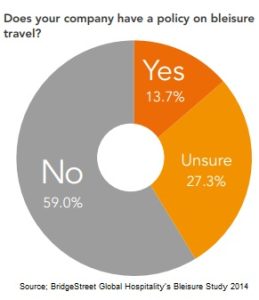According to a recent GBTA study, more than a third of North American business travelers have extended a business trip to add on a vacation. More than half those taking these bleisure trips bring family members or a significant other with them.
But this brings up a host of questions for companies and their HR leaders around duty of care and where their responsibilities lie in regard to these traveling companions. Not all of these questions have universally-accepted answers, but companies need to consider and decide how to manage and mitigate the risks of family bleisure trips.
Create a bleisure travel policy
 According to a 2014 survey of business travelers, 59% said their company had no policy on bleisure policy; 27% weren’t sure. In order to avoid any confusion, organizations must set specific parameters for bleisure travel. This includes outlining a specific policy around bleisure trips and communicating that information to all employees who may travel on behalf of the company.
According to a 2014 survey of business travelers, 59% said their company had no policy on bleisure policy; 27% weren’t sure. In order to avoid any confusion, organizations must set specific parameters for bleisure travel. This includes outlining a specific policy around bleisure trips and communicating that information to all employees who may travel on behalf of the company.
What a policy should cover
Organizations should make expectations around family and companion bleisure travel clear, not only with regard to when and if it is acceptable to include others on work trips, but also the rules by which the employees and their significant others may need to abide during such trips. This can include setting clear schedules for the start and end of the business portion of the trip and defining what is considered personal vs. vacation time.
Outlining rules ahead of time for bleisure trips, including who is covered and when, is important not only for setting appropriate expectation but also for fulfilling your duty of care.
Expenses should be defined in the company’s bleisure guidelines in order to prevent confusion during or after the trip. Outline which portions of airfare, food and accommodations will be covered by the company. Typically, employees and their travel companions are responsible for paying for expenses incurred during the leisure portion of the trip, whereas the employer will pay for business trip expenses for the employee, including the transportation costs to and from the original destination. For example, if an employee’s plans represent a significant diversion from their original itinerary (say if their business trip began in NYC, but ends in Hawaii), then travelers may be expected to compensate their employers for the difference.
For a morale boost, can employees use the corporate discounts to book their family vacation? And, is the company willing to let the employee and their travel partners book using the organization’s preferred provider to encourage compliance?
Travel risk issues
Additionally, employers should lay out the parameters of insurance and/or travel risk management services during the trip — at what point do services for employees begin and end, and are family members included in those programs? Can they use the company’s travel risk management firm’s services during the leisure portion of their trip? Company leaders may be wondering whether they can restrict certain aspects of their employee’s bleisure travel. An example of a reasonable advance restriction may be discouraging family bleisure travel to high-risk destinations. Answering these questions prior to travel can help both the organization and the worker navigate the trip more smoothly.
Duty of Care — Whom does it include?
While organizations don’t employ an individual’s entire family, some employees may assume that their company will help care for their family members if any health or safety issues pop up. When it comes to business trips, the level of care (if any) that employees’ family members can expect to receive on such trips must be outlined ahead of time. This will prevent any potential confusion among employees.
For example, an organization’s travel policy should outline whether immediate family is covered by the business’s assistance and insurance programs, and whether coverage includes overseas destinations. Communicate this information clearly to employees so they can plan to cover any gaps in coverage for their bleisure travel companions. Additionally, if an organization has a travel risk management firm, share information on whether family members can use those services in the event that any health or security issues arise during the trip.
Employers should also share all information relevant to the business destination before travel commences. Make sure employees understand the destination-specific health and security risks that can pose problems for them and their families. This will help workers and their travel companions prepare for these risks and perhaps even help to prevent certain health and safety issues.
In sum, organizations should develop proactive plans that address all aspects of bleisure travel in order to mitigate the inherent risks. It’s not enough to just have a plan in place, however. Companies should also communicate clearly to their traveling employees what these plans entail. This will encourage open dialogue and help protect the safety of employees, their travel companions, and the employer.
